Exploring Titan: NASA's Revolutionary Dragonfly Mission
Written on
Chapter 1: Introduction to Dragonfly
On June 27, 2019, NASA revealed that Dragonfly would be the latest mission in its New Frontiers program. This groundbreaking endeavor aims to explore Titan, Saturn's largest moon, and examine its potential to host life on this intriguing celestial body.
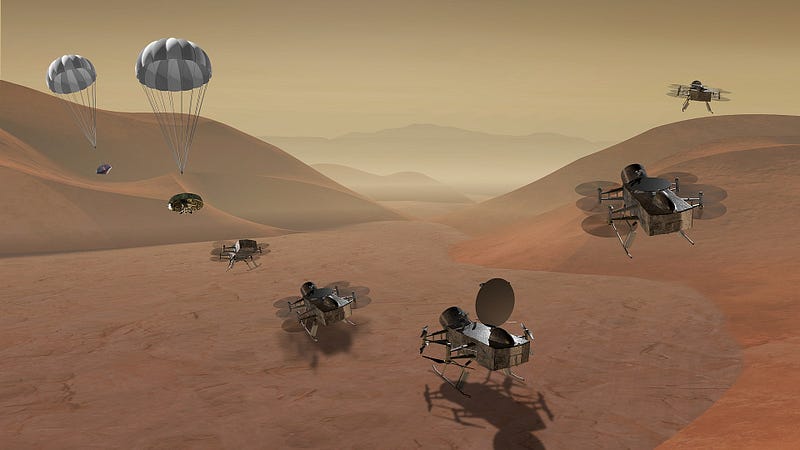
Artist’s representation of Dragonfly's descent and flight. Credit: NASA.
What Is Dragonfly?
This mission involves deploying a sizable drone to Titan's surface. Once it safely lands, Dragonfly will be able to "hop" across the moon, allowing researchers to study multiple locations.
Dragonfly is the fourth mission under NASA's New Frontiers program, which focuses on planetary exploration. Previous missions in this program include New Horizons, which visited Pluto in 2015, Juno, currently in orbit around Jupiter, and OSIRIS-REx, which is studying the asteroid Bennu. The competition for the next New Frontiers mission began in 2017, with Dragonfly proposed by the Johns Hopkins Applied Physics Laboratory. It was selected alongside CAESAR, a comet sample return mission, and officially announced as the winner in June 2019.
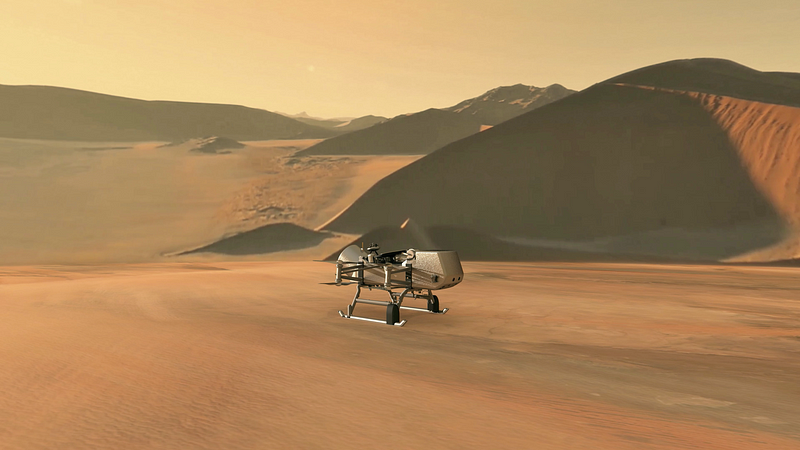
Artist’s impression of Dragonfly navigating the skies of Titan. Credit: NASA.
The mission will utilize a large, nuclear-powered drone capable of maintaining flight for several hours within Titan's atmosphere. Estimates indicate that the drone can achieve speeds of up to 36 kph (22 mph) and ascend to altitudes of 4 km. Unlike previous robotic missions on Mars, which were limited by slow movement and challenging terrain, Dragonfly can cover distances of up to 40 km (25 miles) in a single hop, surpassing the travel range of Mars rovers over years.
While the ability to fly across Titan is thrilling, the majority of scientific analysis will occur on the ground. Equipped with instruments to analyze surface materials and chemical properties, Dragonfly will search for signs of life and assess the moon's habitability. The thick, hazy atmosphere has kept Titan's surface largely a mystery, and this mission will enable detailed studies of its enigmatic landscape.
Have We Explored Titan Before?
Titan has previously been visited by four missions: Pioneer 11, Voyager 1, Cassini, and Huygens. Pioneer 11 and Voyager 1 conducted flybys in 1979 and 1981, respectively, gathering data on Titan's size, mass, and composition. Voyager 1's observations indicated the existence of liquids in the atmosphere and on the surface, a detail later confirmed by the Hubble Space Telescope.
The most comprehensive research on Titan was conducted by the Cassini-Huygens mission, which orbited Saturn from 2004 to 2017. Cassini performed numerous close flybys of Titan and partially mapped its surface using radar. The mission also included the Huygens lander, which made the first landing on a moon other than Earth's, giving humanity its first glimpse of Titan's surface. Initial images revealed formations resembling rivers and dried lakes, while later data confirmed the presence of liquid methane lakes.
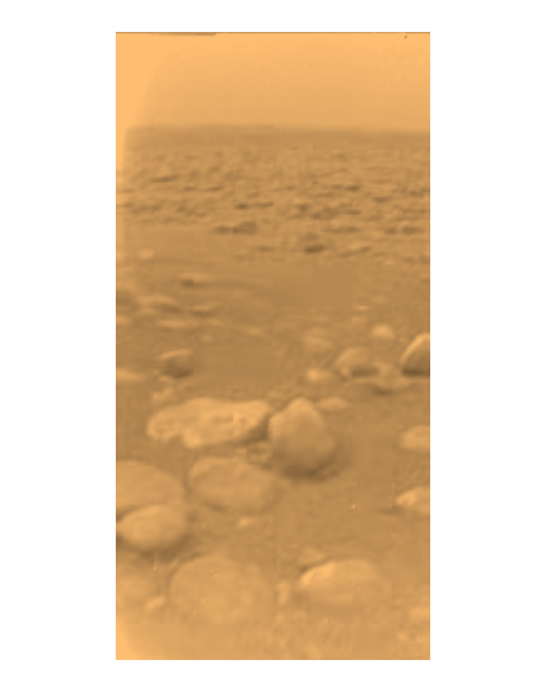
Huygens’ perspective of Titan's terrain. The visible rocks are actually pieces of water ice. Credit: ESA.
Why Titan Is Unique
Titan stands out as the only moon in our solar system with a dense atmosphere, which is also nitrogen-rich like Earth's. It is one of the largest rocky bodies in the solar system, larger than Mercury and significantly bigger than our Moon. With a surface gravity about one-seventh that of Earth and a great distance from the Sun, Titan is much colder than our planet. However, it shares several similarities with Earth.
Due to the frigid temperatures, any water on Titan's surface exists as solid ice. Conversely, methane, which is gaseous on Earth, is liquid on Titan, forming clouds, rain, and bodies of water. Titan's landscape comprises shifting carbon-rich sands, and volcanic activity can occur due to occasional eruptions of liquid water from its interior.
The slow evaporation rates on Titan, coupled with its unique atmospheric conditions, lead to distinct weather patterns compared to Earth. Some areas may experience prolonged periods of drought, followed by sudden heavy rainfall that replenishes lakes and seas.
Life, as we understand it, relies on various compounds, including carbon, nitrogen, oxygen, and hydrogen, along with trace elements like sulfur and phosphorus. Titan is abundant in carbon and nitrogen, and Dragonfly may uncover chemical evidence that illuminates the origins of life on Earth. Whether life exists on Titan remains a topic of debate; earlier assumptions suggested that the absence of liquid water and extreme temperatures precluded life. However, Cassini's findings of fluctuating atmospheric gases hint at the possibility of primitive life forms. A key objective of the Dragonfly mission is to explore the extent of chemical processes that may lead to biological activity on Titan.
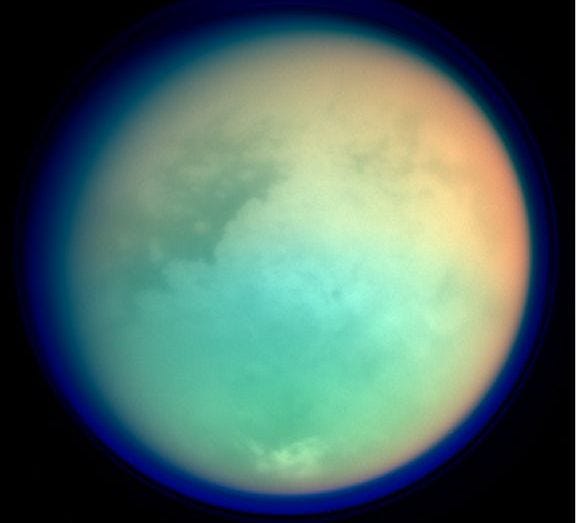
Titan as viewed from Cassini. Credit: Cassini Imaging Team, SSI, JPL, ESA, NASA.
When Will Dragonfly Arrive?
NASA plans to launch Dragonfly in 2026, with an anticipated arrival on Titan in 2034 after an eight-year journey. The landing site has been selected to mirror the climatic conditions experienced by Huygens in 2005 and is believed to closely resemble the Namib Desert on Earth, providing confidence in a safe landing.
What Will Happen Upon Arrival?
Dragonfly is expected to land in an area of Titan known as Shangri-La, characterized by dark dunes likely composed of shifting hydrocarbons and possibly remnants of an ancient seabed. This site was chosen based on prior observations from Cassini and Huygens.
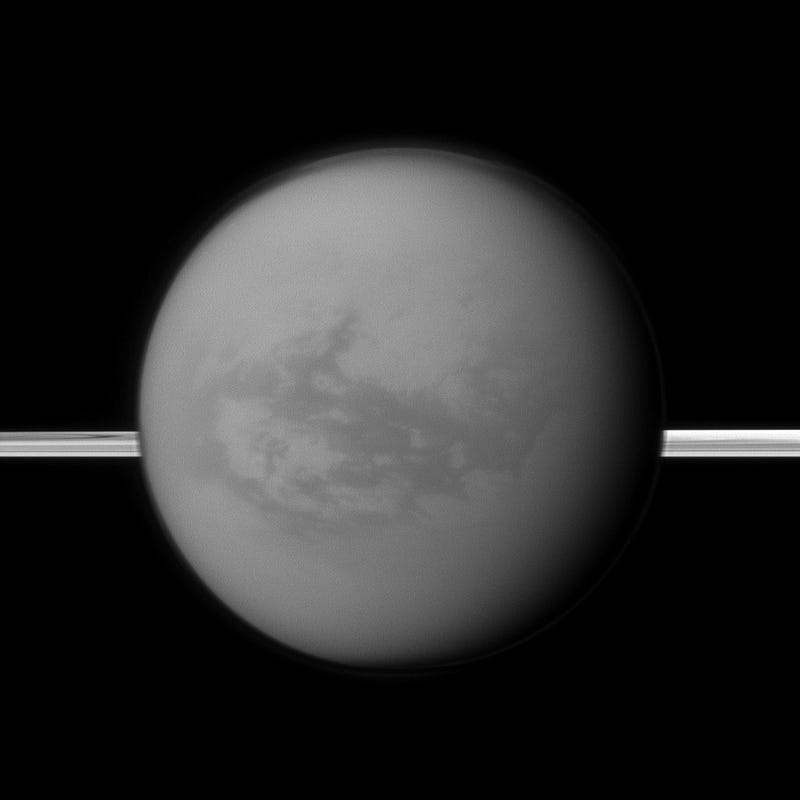
Titan, with Saturn's rings in the backdrop. The dark region labeled Shangri-La will be Dragonfly's landing zone. Credit: NASA/JPL-Caltech/Space Science Institute.
After landing, Dragonfly will conduct a series of hops around Shangri-La, gradually increasing the distance of its flights as researchers build confidence in the craft's capabilities. A day on Titan lasts about seven Earth days, followed by an equally lengthy night. Scientists plan to conduct exploration activities during daylight hours while allowing the craft to recharge during the long nights.
Following its explorations in Shangri-La, Dragonfly will move to the nearby Selk crater, which has been extensively imaged by Cassini. This relatively young crater offers the opportunity to sample material from deep within Titan, as erosion has not yet buried its surface.
Why This Mission Matters
This mission holds the potential to answer two of science's most profound questions: How did life begin on Earth? And is there life elsewhere in the universe?
Our understanding of where life might exist has evolved significantly. Initially, the extreme cold of Titan's surface was thought to eliminate any potential for life. It was long believed that liquid water was essential for life, confining it to planets with warmer temperatures like Earth.
However, recent missions have identified various ocean worlds in the outer solar system, prompting scientists to reconsider the possibility of alternative life forms in these environments. Among these ocean worlds, Titan may be the most promising candidate for hosting life. Even if we do not discover extraterrestrial life on Titan, studying its chemical environment may provide insights into the conditions on early Earth, shedding light on how life originated.
The Dragonfly mission is not only significant for the scientific revelations it may yield but also represents an impressive engineering feat. Successfully landing and operating a drone on a distant moon could pave the way for future missions to explore other fascinating worlds in our solar system.
The first video titled "Dragonfly: NASA's New Mission to Explore Saturn's Moon Titan" provides an overview of this revolutionary mission, detailing its objectives and significance.
The second video titled "Dragonfly in the Desert: Testing for Titan" showcases the testing processes for the Dragonfly mission, highlighting its engineering and design challenges.